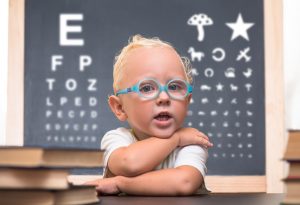In this Article
- What is Strabismus?
- Types of Squint
- Causes of Strabismus in a Baby
- How to Identify Strabismus in Your Baby?
- Effects of a Squint on Baby’s Vision
- How to Test Your Infant for Squint?
- Squint Eye Treatment for Babies
- What Is Amblyopia (Lazy Eye)?
- How to Identify Amblyopia in Your Child?
- How to Test Your Baby for Amblyopia?
- Treatment for Baby Amblyopia
All parents hope that their child is physically and mentally fit and is not born with a deformity. A squint in your baby’s eyes can come as a shock can be an emotionally trying period for you. This article seeks to allay your fears about squint and amblyopia if your baby is affected by it at birth or if it recognizing later on.
What is Strabismus?
A complete lack of coordination between the eyes is known as strabismus where your child’s eyes may seem misaligned or crossed. It is also known as a squint. This is a vision-related issue where both the eyes are unable to focus at the same point, at the same time. The eye muscles of both eyes are coordinated and move in the same direction when we want to focus on a specific object. Strabismus prevents our eyes from doing so. A child may seem cross-eyed when her brain is unable to merge the vision of both eyes since the eye muscles do not work in tandem with each other.

Types of Squint
Squints are classified into various types as follows. These are the types of squint or misaligned eyes found in children:
- Direction of the squinting or turned eyes
- Esotropia-When the eye turns inwards
- Exotropia-When the eye turns outwards
- Hypertropia-When the eye turns upwards
- Hypotropia-When the eye turns downwards
- Constant squint: The squint is present all the time while intermittent squint is when the squint is sporadically seen.
- Manifest squint: The eye turns only when it is open while latent squint is when the eye is covered or shut.
- Concomitant Squint: In this case the eyes have muscles working properly, but the eyes are always non-aligned irrespective of the direction they turn to.
- Incomitant Squint: In this case, the angle of squint can change. When the eye turns to the left, the eyes could be properly aligned, but when the eye turns to the right, the squint is noticeable.
Causes of Strabismus in a Baby
Though there is no known cause for childhood strabismus, this eye condition tends to run in the family. Strabismus also develops in a child when the eye compensates for vision issues like cataract and farsightedness. In some instances, your child could be at risk of developing strabismus due to Down’s syndrome, premature birth, head injury or a condition that affects the nerves and muscles. Some children may be born with strabismus or can develop it during the first six months without a specific reason. Baby squinting eyes could also occur due to problems like myopia, astigmatism or hypermetropia, where the light does not focus properly on the retina.
How to Identify Strabismus in Your Baby?
It is relatively easy to identify a permanent squint in your child since the eyeballs constantly deviate from each other. Remember, your newborn will have some alignment issues till the eyes and the brain coordinate and function as a team. Most babies will have an intermittent squint till about six months which is healthy as this will vanish before you know it. It needs medical attention if it continues beyond a year. Strabismus can be identified by taking a front-facing photo of the baby where it focusses straight ahead. This way the deviation in the eyes can be detected.
Effects of a Squint on Baby’s Vision
As an alert parent, you should not ignore a squint if it is persistent or if it is noticed even after the baby is 3-4 months. If untreated, squint could cause persistent blurred vision or double vision. It could also lead to a lazy eye in which case the brain ignores the signals it receives from the squinted eye. This does not allow the child to develop a healthy vision. Since the visual effect isn’t good, the child could face isolation and will feel embarrassed in social situations. It is best to treat a squint at a young age since vision problems can get enhanced as the child grows in age.
How to Test Your Infant for Squint?
It won’t be easy to test your baby for squints since she is unable to explain and cannot speak. You could visit an ophthalmologist for a small test at the clinic where the doctor will cover one eye and check the line of vision towards the light or an object. He will then check the eyeballs for any movement by removing the cover. This simple test does not cause any discomfort to the child and is effective too.
Squint Eye Treatment for Babies
The following are the commonly recommended treatments for squint eyes in babies:
Injections to the eye muscles: Although the effect of these injections can last up to three months only, they help in weakening the eye muscles due to which it becomes easy for the eyes to align correctly.
Surgery: During surgery, eye muscles that control movement are corrected so the eyes can align themselves. An operation is often the last resort, especially for babies.
Eyeglasses: If the squint is a result of problems like long-sightedness, then eyeglasses can be the right solution to treat this condition.

What Is Amblyopia (Lazy Eye)?
When a squint isn’t treated at an early age, it can develop into lazy eye or amblyopia. Amblyopia, also known as lazy eye, occurs when the brain reduces vision to one eye or both eyes or even shuts it off completely. Since the affected eye sends blurred images to the brain, the brain ignores it at times. It occurs due to misalignment of the eye or reduced vision due to cataract, droopy eyelid, astigmatism, etc. If treated at an early age, a child can recover his vision entirely but ignore it can lead to total loss of vision too.
How to Identify Amblyopia in Your Child?
Identifying amblyopia can be a tricky proposition for most parents since children can manage their day to day activities using just one good eye. Your child isn’t using the defective eye to see, and it doesn’t seem any different from the normal eye. Mothers are alert towards any changes in their baby’s body, and hence there is a good possibility of you recognising this condition in your child. The paediatric ophthalmologist is the best bet to check for amblyopia if you are unsure of your method.
How to Test Your Baby for Amblyopia?
If you are keen to test your baby for amblyopia at home before you take her to the doctor, do the following test:
Cover your baby’s eye (any one) with an eye patch and hold a toy or a teddy bear in front of her and move it sideways, horizontally or vertically. Observe if the child follows the object with her open eye. Now cover this eye and repeat the actions with the toy. This time keep a close watch if the baby has similarly followed the object for an equal distance as earlier. Although there are chances that your baby may quickly lose interest with this exercise, begin with the second eye first when you attempt it the next time.
Book an appointment with a paediatric ophthalmologist or schedule a vision screening to get an accurate diagnosis of this eye condition your baby could be afflicted with.

Treatment for Baby Amblyopia
Worried parents are at a loss about how to correct squint eyes in babies, but a few basic steps initially can help treat your baby of amblyopia. The first step is to work on the problem that is probably causing amblyopia. Near-sightedness, astigmatism or cataract should be corrected through medication, use of eyeglasses or surgery. Ultimately it is essential for the child’s brain to coordinate its responses with the weak eye which then will enhance its ability to see well.
If amblyopia has occurred due to weak eyes, the doctor will recommend eyeglasses which work as a sharp camera lens, thus helping the objects to remain in focus. The brain receives a more precise image and will improve the link between the brain and the eyes.
Doctors will suggest covering the right eye with an eye patch thus forcing the brain to focus on the weak eye. The doctor can also recommend temporary blurring of the healthy eye by the use of eye drops once a day. This too will force the brain to use the weaker eye. This process may take a long time to show its effect, weeks or months and sometimes years also.
Strabismus and Amblyopia are eye conditions that can be corrected efficiently if they are diagnosed and treated in the early stages. Seek immediate treatment and ensure that your child does not develop a negative complex about himself due to this. Squint can affect your child’s appearance to ensure you are supportive of his/her condition throughout this journey till a solution is found.









